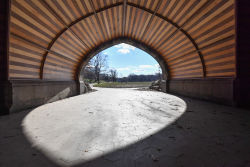Prospect Park
Lena Horne Bandshell
What was here before?
Planning for Prospect Park started in 1859; it was designed in 1866 by Fredrick Law Olmsted (1822-1903) and Calvert Vaux (1824-1895) and opened the next year. The area of the park encompassing today’s bandshell was formerly part of the estate of railroad magnate Edwin Litchfield (1815-1885).
The western perimeter of Prospect Park was the last and most expensive section of the park to be secured. Early plans by Olmsted & Vaux left the area blank, but by 1888 a map labels it the Archery Ground. By 1918, it was used by girls’ field hockey teams.
How was this bandshell created?
A tradition of concerts in the park dates to 1870 with the creation of the Concert Grove and in 1887 the Music Pagoda. In the 20th century, bandshells became popular for their acoustical properties and hardscape that permitted dancing.
Funded by the Depression-era Federal Works Progress Administration (WPA), the Prospect Park bandshell was designed by the Parks Department’s Chief Consulting Architect Aymar Embury II and opened in 1941 along with the adjacent playground.
In the 1940s and 50s the bandshell hosted dance concerts by the likes of Benny Goodman and Cab Calloway attracting large crowds. Musical programming here diminished until the Celebrate Brooklyn Performing Arts Festival, launched in 1978, revived the tradition of well-known contemporary popular musical acts. BRIC, a local arts organization, provides a varied program of world-music, classical and new music, jazz, pop and alt-rock and hip hop.
Who is this bandshell named for?
In 2021, as part of the second phase of NYC Parks’ initiative to expand the representation of African Americans honored in parks, this bandshell was named for legendary Brooklyn-born singer, actress, and civil rights activist Lena Mary Calhoun Horne (1917–2010). Horne was born in Bedford-Stuyvesant, Brooklyn and attended Girls High School before she dropped out at age 16 to join the chorus line at the famous Cotton Club in Harlem.
In 1934, Horne made her Broadway debut in Dance With Your Gods and returned for Lew Leslie's Blackbirds of 1939. She was featured in two films before signing a seven-year contract with Metro-Goldwyn-Mayer (MGM) which, along with nightclub performances and radio appearances, made her the top earning Black performer of the time. Her first Hollywood film was Panama Hattie (1942), followed by smaller roles where she performed alone so that it was easier to cut from the film to appease Southern audiences. During this time, she was in all-Black films such as Cabin in the Sky (1943) and Stormy Weather (1943).
During World War II, Horne performed with the USO but cut ties after Black servicemen were seated behind German POWs. However, she continued to perform for the Black GIs of the segregated US Armed Forces. Horne used her fame to bring attention to the National Council of Negro Women, NAACP, and the March on Washington in 1963. Horne advocated for roles that didn’t depict Black people as subservient or unintelligent.
Throughout the 1950s and 1960s, she mostly toured the nightclub scene performing around the United States and Europe. In 1981, Horne won a Tony Award for Lena Horne: The Lady and Her Music and in 1984, she was awarded Kennedy Center Honors Lifetime Achievement Award in 1984 for her contributions to American culture.
Check out your park's Vital Signs
Clean & Safe
Green & Resilient
Empowered & Engaged Users
Share your feedback or learn more about how this park is part of a
Vital Park System











